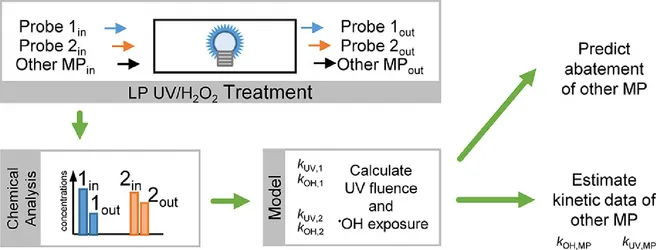Organic micropollutants (MPs) are increasingly detected in water resources, which can be a concern for human health and the aquatic environment. Ultraviolet (UV) radiation based advanced oxidation processes (AOP) such as low-pressure mercury vapor arc lamp UV/H2O2 can be applied to abate these MPs. During UV/H2O2 treatment, MPs are abated primarily by photolysis and reactions with hydroxyl radicals (•OH), which are produced in situ from H2O2 photolysis. Here, a model is presented that calculates the applied UV fluence and the •OH exposure from the abatement of two selected MPs, which act as internal probe compounds. Quantification of the UV fluence and hydroxyl radical exposure was generally accurate when a UV susceptible and a UV resistant probe compound were selected, and both were abated at least by 50 %, e.g., iopamidol and 5-methyl-1H-benzotriazole. Based on these key parameters a model was developed to predict the abatement of other MPs. The prediction of abatement was verified in various waters (sand filtrates of rivers Rhine and Wiese, and a tertiary wastewater effluent) and at different scales (laboratory experiments, pilot plant). The accuracy to predict the abatement of other MPs was typically within ±20 % of the respective measured abatement. The model was further assessed for its ability to estimate unknown rate constants for direct photolysis and reactions with •OH. In most cases, the estimated rate constants agreed well with published values, considering the uncertainty of kinetic data determined in laboratory experiments. A sensitivity analysis revealed that in typical water treatment applications, the precision of kinetic parameters for UV susceptible and for UV resistant probe compounds have the strongest impact on the model's accuracy.
